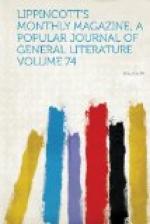The servant, Maria, whose maternal grandmother was a countess, was making some last arrangements in the room.
“Come and see what a beautiful new moon there is,” I said to her.
She came to the window and looked toward the west. “That isn’t the moon: it is a star,” she said, fixing her eyes upon Venus.
It was quite characteristic of her class. They all think forestieri do not know the moon from a star.
I pointed lower down, to where an ecstatic crescent was melting in the sunset gold.
She gazed at it a moment, then said: “It is beautiful: I never noticed it before. I never look at the sky except to see what the weather is to be. It is for you signori to look at beautiful things, not for us poveretti.—Do you see the sky in America?” she asked presently.
I assured her that we do, and that the sun, moon and stars shine in it just as here in Italy.
She was greatly puzzled. “I thought that America was under ground,” she said.
I remembered Galileo and held my peace. Besides, in these days of universal knowledge, when we hear scientific terms lisped by infant lips, it is refreshing to see an example of fine old-fashioned ignorance. Yet this woman had better manners than are to be found in most drawing-rooms, a sweet, courteous dignity, and in matters which came within her personal knowledge great good sense and judgment. Only she had never learned that from the centre of the earth all directions are up.
Of course a stranger’s first visit in Asisi is to the basilica of San Francesco, and, though I had seen it before, I lost no time in renewing my acquaintance with it. This church is not only the jewel of Asisi, but one of the most precious of Italy. It is among churches what a person of genius is in a crowd. The rich marbles one sees elsewhere suggest the mechanic in their arrangement, and one grows almost tired of them; but here the soul of Art and Faith has poured itself out, covering all the wide walls, the ceilings, the sides of arches, the ribs of groinings—every foot of space, in short—with life and color; and how much more precious is one of those solemn pearly faces than a panel of alabaster or the most cunning mosaic of marbles! In the upper church alone there are twenty-two large frescoes of Cimabue and thirty of Giotto. Over these pours the light from fourteen large colored windows, unimpeded by side-aisles. When the sun beats upon these windows the church seems to be filled with a transparent mist softly tinted with a thousand rich hues. The deep-blue, star-sown vault sparkles and the figures on the walls become a vision.
The upper church has been in danger of losing its beautiful choir, a marvel of carving and intarsio, which Cavalcasella, inspector of fine arts in Italy, removed for the odd reason that it was a work of the fourteenth century, while the church was of the thirteenth, and to be in perfect keeping should have a stone choir. I have not learned whether this hyper-purist will require of the congregation a thirteenth-century costume when the church is again open for service.




